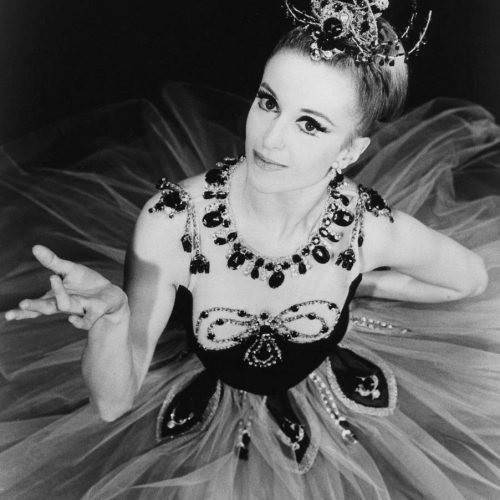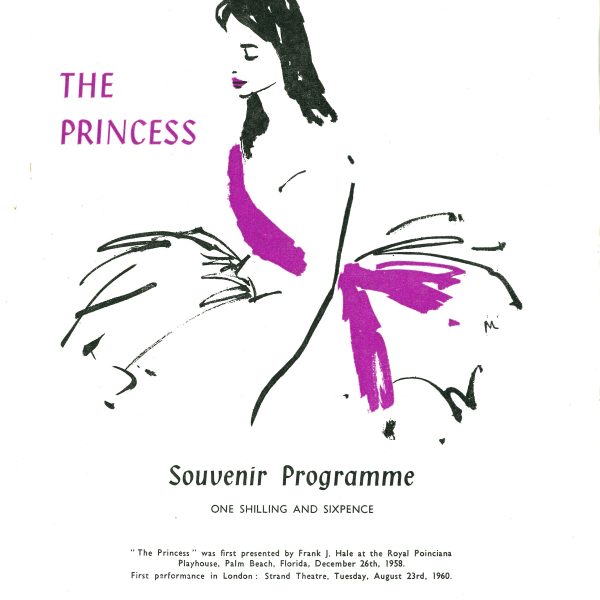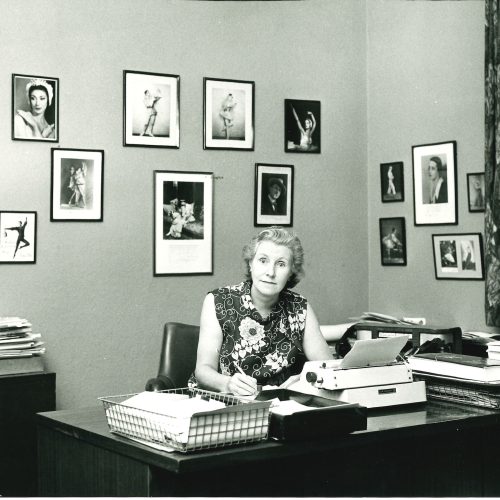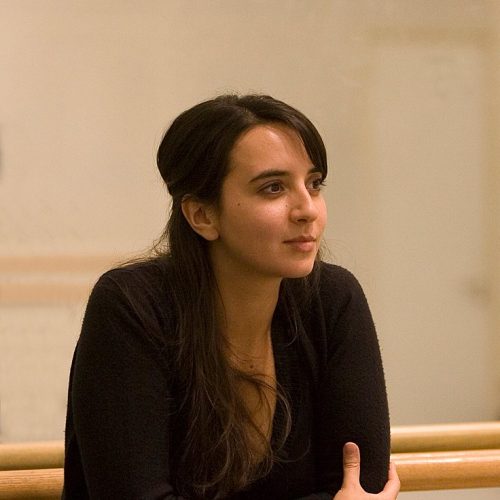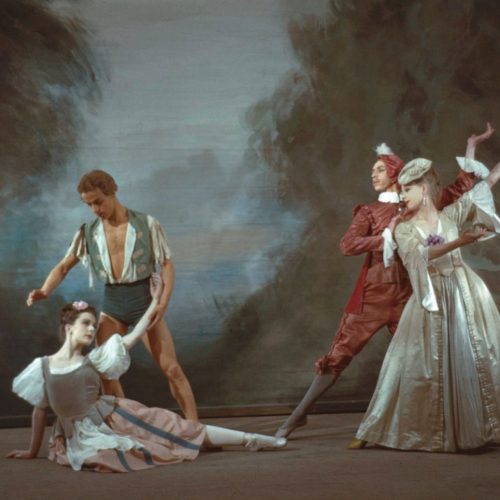Violette Verdy
This interview with Violette Verdy is introduced by the dance critic and historian Alastair Macaulay. Violette Verdy’s laughter and intelligence shine through in this discussion with Clement Crisp. She explains how, as dancer and actress, music was the core of her existence. She talks about working with George Balanchine, of doing new pieces with him, of his musical sophistication in dealing with difficult scores, and of the spiritual dimension to his work. Jerome Robbins, with whom she also worked, was a complete perfectionist, and in Balanchine’s view the American choreographer. Yet, at the height of his career and fame, Robbins always regarded Balanchine as his only master.
First published: March 31, 2025
Biography
Violette Verdy, originally Nelly Armande Guillerm, was born in Brittany, France, in 1933. In 1942 her mother took her to Paris to acquire the best ballet training available, studying under Carlotta Zambelli, Rousanne Sarkissian and Viktor Gsovsky. By 1945 she was in the corps de ballet for Roland Petit and then part of his Ballets des Champs-Elysees. In 1949 she starred in Ludwig Berger’s film Dream Ballerina (released in 1950), when she changed her name to Violette Verdy. In 1953 she made her first trip to America, again with Petit and his Les Ballets de Paris. The following year, as well as dancing with London Festival Ballet, she danced at La Scala, Milan, in two ballets by Alfred Rodrigues and also in Coppélia and Giselle with Ballet Rambert.
The next phase of her life began when Nora Kaye asked her to join American Ballet Theatre in 1957. Verdy went on to join Balanchine at New York City Ballet in 1958. While she continued to dance with many companies in many countries, it was with Balanchine and Robbins that her brilliance shone brightest, and where many leading roles were created on her. Her two decades in New York secured her place in ballet history.
Violette Verdy retired from dancing in 1977. She became the first female Artistic Director of the Paris Opéra until 1980. Her directorial skills honed, she went on to Boston Ballet, where she stayed until 1984 and then became Distinguished Professor of Music (Ballet) at Jacobs School of Music in Indiana University. In her later years she undertook guest teaching residences with many of the leading ballet companies in the world, including the Bolshoi, where she was the first foreign teacher to work there since the 1917 revolution. She was given many honours and awards, not least the Légion D’Honneur. She could dance, act, choreograph, direct, teach and, most of all, inspire. But all her answers were in the music and the multiple layers of meaning that imbued her dancing began and ended with that. Violette Verdy died in Bloomington, Indiana in 2016.
Transcript
In conversation with Clement Crisp
Clement Crisp: If you say Violette Verdy to people, they always say: ‘the most musical dancer in the world’.
Violette Verdy: You know, in a way, if I had to choose, to lose music entirely forever or lose dance forever, I would choose to stay with music. I mean, music is like, essential for me. Because one of the reasons my mother realised that she might have to have me dance, because I had a response to music in my very early years that was so strong that she didn’t know what to do with me. I would be either completely down with emotion and sadness, or up and needing to dance. And the family doctor said, ‘You know, she has too much energy for her little body, and we have to quiet her down. But we have to tire her out harmoniously’. These were his words. And my mother said, ‘Would you say she could dance, maybe?’ And he said, ‘Yes, why not’.
So I steep, I marinate, I infuse with music. All the time. I have to have it.
Clement Crisp: But there you could, I mean, because, we’re talking about you being musical. But there was also the fact that you were an extraordinarily penetrating and compelling dance actress.
Violette Verdy: I had a quality as a comedienne. And also as a dramatic dancer.
Clement Crisp: Yes. Yes, yes, yes.
Violette Verdy: I could have done more of those things, naturally, that was not the tenure, you know, of the Balanchine company. Of course. But in [at] the same time, there were occasions for me to do it. And I have to tell you something very funny. I got an incredible review once for dancing Medea. I had done the Princess which is obviously my role. And I said to Mr. B, ‘You know, I’d love to do Medea’. He said ‘Fine with me’. And John Martin wrote something about, he said, ‘I have no doubt, having seen her Medea, that she could do Jason. And maybe even King Lear’. So that was very flattering.
Clement Crisp: Yes. Yes
Violette Verdy: I suppose I was maybe a little bit too high in tone and colours sometimes, in the Balanchine repertory, and somebody had said something about my second act Swan Lake, that I had managed to insist on doing the four acts in the second act. Something like that.
Clement Crisp: Yes.
Violette Verdy: Which shows that I was pushing my luck a little bit. There were times when choreographers were not very educated in music. It’s much more rare today, thank God. They really know what they’re doing usually, and they have an idea of the score, and maybe not like Balanchine. You know there’s one thing I wanted to tell you, to see how far it went with Balanchine. When Stravinsky decided to, you know, try his hand at dodecaphonic music, Balanchine actually studied it at the same time he did. And we – here we were, doing a beautiful huge ballet by Balanchine called Episodes.
Clement Crisp: Of course.
Violette Verdy: And my section was Symphony Orchestra 21 which is very, very sparse music, taut and very rare. There was no such thing as a piano reduction, of course, for the rehearsal pianists to work with the dancers, and it was kind of difficult for them to help us with the rehearsals. So Balanchine said, ‘Don’t worry, I’ll do a reduction’, so people went ‘Oh my God’. And he did. He pencilled a little reduction for the pianist to be able to have the essential bars, divisions of the music and everything, and that is at Harvard [University Theatre Collection], so if somebody didn’t believe it, they can go and see it at Harvard.
Clement Crisp: Yes. Yes.
Violette Verdy: Thank God it had been salvaged and everything, isn’t that amazing?
Clement Crisp: But that is music. Where you have to be… have a very sophisticated ear. And a very sophisticated understanding of how the dance and the music matches.
Violette Verdy: Well, we had counts.
Clement Crisp: Yes.
Violette Verdy: We had to have a few counts.
Clement Crisp: Of course.
Violette Verdy: And one of the things that became, you know, one of the trademarks of New York City Ballet was the silent ones. You know like, you know, you watch the conductor, you know like in Agon.
Clement Crisp: Yes.
Violette Verdy: He goes ‘one’ and no music at all because the one is silent. [laughing] But you better know that that is the one and then at two, three, four, five, you know.
Clement Crisp: Yes, yes, yes.
Violette Verdy: So that was kind of something we were all very good at that. And I also, I was amused that when I did Agon, it was kind of early when I was in America, and my English was alright but not maybe as good as it has become. [laughing] And I realised quickly that I’d better count in English, because if I was losing my counts, my French counts wouldn’t work for me to know where I was if somebody said ‘eight, nine’, ‘one’, you know, next to me, so…
Clement Crisp: But you see, that’s again a very difficult score.
Violette Verdy: Yes. It’s not easy. It’s not easy. I didn’t have to confront those difficulties very often. To tell you the truth, first of all I didn’t have one of those wonderful long Anglo-Saxon body, with the long shin bones and thin, no hips. I had a French body, much more reduced, like Balanchine said, very good proportions. But those ballets, where you were in a leotard, were not the best for me to show up into. And Balanchine knew that, and he did a little bit of that with me, but not a lot. Not a lot really. Agon and Episodes were the only two, really. I was so lucky that Balanchine loved France so much. But I always told people that he was loving France with a Russian eye. He saw, like the Paris Opera, like the Temple of the Dance. And for me, he felt, as if a link with his past, and with his love of France, I was a little link. He told me, he said: ‘You will be my little graft for style’. Because he said, ‘American dancers, as wonderful as they are’ and he said, ‘You can ask them to do anything, because they have no preconceived idea, but sometimes they also have no style’. So I inherited lots of great French occasions with him.
Clement Crisp: When Mr. Balanchine did Sonatine for you, I mean there again, France was speaking to France.
Violette Verdy: Oh yes. He did it during an Easter weekend. When we were, yes, he asked us, ‘Would you mind if we do it this weekend?’ ‘No Mr. B of course, of course! If you want.’ Yes. And we were in Kennedy Center, performing, and we had a second week coming.
Clement Crisp: Yes.
Violette Verdy: And we worked the whole weekend. Hours, we were, we didn’t want to say, he would say, ‘Are you alright? Are you not too tired?’ ‘No, no, Mr. B, no, no Mr. B’ because it was pouring out.
Clement Crisp: Ah.
Violette Verdy: And we didn’t want to interrupt. I mean, you know, and we were dying but –
Clement Crisp: [laughs] Yes. Of course.
Violette Verdy: And he did, he did the whole thing in an Easter weekend. It was like sharing a gourmet dinner with someone and talking about the food and going, you know, and talking about another nice conversation.
Clement Crisp: Yes.
Violette Verdy: But also about the food, not forgetting the food. All the due to the food, you know, like, really, it was amazing doing a new piece with him. And he came prepared musically. By then, when he had completely gotten a hold of the whole music, he said, ‘I know what I want it to look like’ and he said where it is, the situation, the atmospher. ‘So then I have an idea of who the dancers should be.’
So then he lets the dancers that he thinks are going to be the one, do their own contribution.
With Balanchine, he loved for you to do you own, your own understanding of the phrasing and your own rubatos, ritards, all those things. And he encouraged dancers to have all that.
Clement Crisp: One of the supreme examples of course, is Emeralds.
Violette Verdy: Oh yes.
Clement Crisp: That ravishing choreography he gave you.
Violette Verdy: Oh yes.
Clement Crisp: But it was Balanchine and you together.
Violette Verdy: Yes. And he told me, he said, ‘OK, these are the steps, and then you have those little runs to go to the diagonal, you know. There’s a little ritard there, you can do, maybe a little sotto. You decide.’ So he always gave me the main bulk of the steps and he allowed me to organise the in between.
Do you know what he told me one time? And coming from him, from it was practically a confession.
Clement Crisp: Yes.
Violette Verdy: He said: ‘You know, Violette, the, the worst, the most difficult thing for me is not the giving. I have so much that I would like to give.’
Clement Crisp: Yes.
Violette Verdy: ‘People don’t want to take. Sometimes people don’t want to take.’ I said, ‘So, what then?’ He said, ‘I wait, like elephant. Elephant with very good memory. I’ll wait.’
Clement Crisp: What you found, and you found it, I’m sure, with Balanchine, is the benefits of self-destruction, of self-denial.
Violette Verdy: We were charmed out of ourselves, by him. We were attracted, without being able to resist, by something that we suspected, even if we didn’t know, was going to be bigger, better, more extraordinary. And not only that, something almost unknown, because we were not the conceivers of that dimension.
Clement Crisp: No, no, no, no.
Violette Verdy: He was the only conceiver of that dimension. We saw that there was something there, that if we followed it, we would be…
Clement Crisp: Yes.
Violette Verdy: Into it.
Clement Crisp: Yes. It is surrender.
Violette Verdy: Surrender.
Clement Crisp: The fact that you were, you are, so aware of the spiritual dimension of everything you did.
Violette Verdy: My teacher Rousanne had considered dance as being sacred, and she was forever preaching and showing and talking about that. All the good people I worked with, they had that. And Balanchine, my God, I mean, always.
Clement Crisp: Balanchine, of course, said, ‘La danse est une question morale’
Violette Verdy: Morale. And morale is very nice. And it goes that far, but that’s not even the whole story.
Clement Crisp: No.
Violette Verdy: It’s much more. It’s a question, une question spirituelle. Vraiment.
Clement Crisp: [Lincoln] Kirstein always said about Balanchine, he was concerned with the angelic.
Violette Verdy: Yes. He [was] definitely, definitely, because he was very religious.
Clement Crisp: Yes.
Violette Verdy: And it was natural for him. The whole mythology of the religion and the mythology of the dance. And being Georgian, and the Greek philosophy. To him, this whole mythology was a natural form of existence to feed himself from, constantly.
Clement Crisp: Yes.
Violette Verdy: You know, Balanchine though, it’s very funny because he had a sense of performance. And he had a sense also that we were, with him of course his great philosophy, we were all at the service. We were a public service. Balanchine always say, ‘I’m a public servant’.
‘And you should be a public servant, dancers.’ You see, so that sort of bypassed the idea of anything else. And also, in that sense, he said, ‘We just give divertissement to the audience. Spectacle. We, you know, we’re there to distract them.’
You know, those were, he was, there was maybe a little bit of an irony, maybe a little bit of a, but he was serious though. He was serious about the general idea.
Clement Crisp: Now, I want to talk to you also about Jerome Robbins.
Violette Verdy: Oh boy! [laughs] So yes, now working with Jerry was something because, he was a perfectionist. And it drove him crazy, because there was no end to it. He never thought that anything he did was ever good enough. And, really, he didn’t believe it. He never got the satisfaction to allow himself to recognise that that was good. So he kept going, going, going, for something better; changing, torturing things, putting them back, dismissing, exchanging, millions of things. And there was nothing we could do but go along with him. Knowing that at some point he would have to make a final decision, and that when we would go on stage we would be alone. We would be allowed to go on the stage alone, and for the first time there would be no Jerry saying, ‘Oh no, but this…’ so we knew there was a little light at the end of the tunnel. Also, because of Balanchine’s admiration for him, we were careful not to dismiss him even when we were dying to do it, when he had been particularly demanding or nasty. And we were careful not to let him down because, really, Balanchine was counting on us to do the carte blanche that he was giving Jerry. And also, we were intrigued by Balanchine’s interest and reaction to Jerry. using us. Balanchine would come and look at what Jerry had done with us. And it was so different that what Balanchine was thinking of doing for us, that he was trying to decipher that, absorb it, accept it, enjoy it, relish it, you know. He was really analysing all this, and it was amazing for him.
Also I personally came to a conclusion about Jerry and Mr. B. Jerry couldn’t have been more successful in America. He was more successful than Balanchine – yes, he was. He was more recognisable to the public. He was more accessible to the public. He didn’t make the public work, or study, like Balanchine did. He made the public immediately enjoy what was done. And, for Robbins, the lack of peace he had and the wonderful peace that Balanchine was in all the time was a complete mystery. And the only master he felt he still had was Balanchine. He never mentioned it in those terms, but I am pretty sure that he saw Balanchine as the only master he could possibly accept to have. And Balanchine told me, one day he said, you know, ‘The real American choreographer is not me. It’s really Jerry,’ he said. I said ‘But Mr. B, what you are’. He said, ‘All right, but it’s Jerry. Jerry is really the American choreographer.’
The transcript of this podcast may have been lightly edited for ease of reading.

